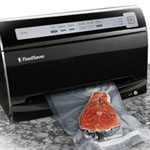
Vitaly Podzorov
One day in 2010, Rutgers physicist Vitaly Podzorov watched a
store employee showcase a kitchen gadget that vacuum-seals food in plastic. The demo stuck with him. The simple concept – an airtight seal around
pieces of food – just might apply to his research: developing flexible electronics
using lightweight organic semiconductors for products such as video displays or
solar cells.
“Organic transistors, which switch or amplify electronic
signals, hold promise for making video displays that bend like book pages or
roll and unroll like posters,” said Podzorov. But traditional methods of
fabricating a part of the transistor known as the gate insulator often end up
damaging the transistor’s delicate semiconductor crystals.

A vacuum food sealer
Drawing inspiration from the food-storage gadget, Podzorov
and his colleagues tried an experiment. They suspended a thin polymer membrane
above the organic crystal and created a vacuum underneath, causing the membrane
to collapse gently and evenly onto the crystal’s surface. The result: a smooth,
defect-free interface between the organic semiconductor and the gate insulator.
The researchers reported their success in the journal Advanced
Materials. In the article, Podzorov and three colleagues describe
how a single-crystal organic field effect transistor (OFET) made with this thin
polymer gate insulator boosted electrical performance. The researchers further
reported that they could remove and reapply membranes to the same crystal
several times without degrading its surface.

Cross-section of organic transistor with vacuum-applied polymer insulator.
Organic transistors electrically resemble silicon
transistors in computer chips, but they are made of flexible carbon-based
molecules that can be printed on sheets of plastic. Silicon transistors are
made in rigid, brittle wafers of silicon.
The methods that scientists previously applied to organic
transistor fabrication were based on silicon semiconductor processing,
explained Podzorov, assistant professor in the Department of Physics and
Astronomy, School of Arts and Sciences. These involved high temperatures,
high-energy plasmas or chemical reactions, all of which could damage the
delicate organic crystal surface and hinder the transistor’s performance.
“People have tendencies to go with something they’ve known
for a long time,” he said. “In this case, it doesn’t work right.”

Fabricating single crystal organic field-effect transistors using ultra-thin polymer membrane for a gate insulator. In the upper row, the membrane is stretched over the transistor before vacuum is applied. In the lower row, the vacuum has been applied and the membrant is adhering to the organic crystal. Photos on the right are close-up views of the transistor, with the organic semiconductor crystal in red.
Podzorov’s innovation builds upon a decade of Rutgers
research in this field, including his invention of the first single crystal
organic transistor in 2003. While his latest innovation is still a ways from
commercial reality, he sees an immediate application in the classroom.
“Our technique takes
10 minutes,” he said. “It should be exciting for students to actually build
these devices and immediately see them work, all within one lab session.”
Podzorov was actually trying to solve another problem when
he first recalled the food packaging demo. He was thinking about how to
protect organic crystals from airborne impurities when his lab shipped samples
to collaborating scientists in California and overseas.
“We could place our samples between plastic sheets and pull
a vacuum,” he said. “Then I thought, ‘why don’t we try doing this for our gate
insulator?’”
Funding for the research
was provided by the U. S. Department of Energy and the Rutgers Institute for Advanced
Materials and Devices for Nanotechnology. Collaborators in Podzorov’s lab were
postdoctoral researchers Hee Taek Yi and Yuanzhen Chen, and undergraduate
student Krzysztof Czelen. The department’s machine shop made a custom-designed
vacuum chamber for the project.
Media Contact: Carl Blesch
732-932-7084, ext. 616
E-mail: cblesch@ur.rutgers.edu


